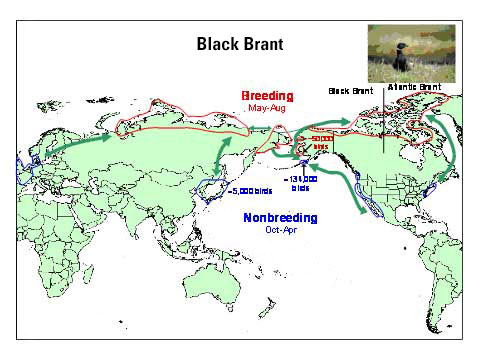Black Brant, Branta bernicla
High-Priority Species ListBrant segregate into breeding populations (colonies) during nesting, to which they show fidelity. There may be mixing among colonies during brood rearing. Molting flocks at Teshekpuk Lake are non-breeders and failed breeders from many colonies across North America and possibly Russia. During the fall staging period at Izembek Lagoon nearly the entire world population of black brant comes together. For the most part, Brant nest in high concentrations (colonies) and during brood rearing, molting, and staging, they concentrate in flocks. Thus, they are relatively easy to capture both on nests with nest traps, and during brood rearing and molting using corral traps. Brant are much more difficult to capture in spring and fall but they are hunted both for subsistence in the spring and fall, and for sport in the fall.
Arrival / Early Nesting
Spring subsistence killed birds could be sampled from the Seward Peninsula (Shishmaref), Saint Lawrence Island, and Yukon Delta NWR. At Izembek NWR samples could also be obtained through collections and fecal samples. Spring sampling will be spread across two broadly defined breeding areas: the Yukon-Kuskowkim Delta (YKD) and the Arctic Coastal Plain. Within each of these areas brant typically nest in colonies which we will sample as clusters. Thus, on the YKD where colony sizes are large, we will sample 70 females from each of 3 major colonies: Kigigak Island, Baird Inlet, and Tutakoke River. Conversely, on the Arctic Coastal Plain, nesting colony sizes are small and samples of 10 females will be taken from 4 distinct colonies. Sampling of nesting females will occur in conjunction with other nesting studies. Females will be captured on nests in incubation and samples will be taken as cloacal swabs.
Molting
Failed and non-breeding birds from a variety of breeding colonies concentrate in the vicinity of Teshekpuk Lake for molt. Large flocks of birds are regularly found dispersed across a series of large lakes. We will sample lakes as clusters, 50 birds per lake from each of 4 lakes, live capturing birds in corral traps and taking cloacal swabs.
Molting flocks of non-breeding birds have also been observed in the vicinity of the Black River on the YKD, however, little is known about their abundance and distribution. Two hundred birds will be sampled to replicate the design used at Teshekpuk Lake if the distribution of birds allows.
Brood-Rearing
Goslings will be sampled from the major breeding colonies on the YKD by driving brood flocks into corral traps. Samples of 200 goslings from each colony will be sampled by cloacal swab.
Fall Staging
Fall staging birds will be sampled at Izembek Lagoon, Morzhovoi, and Bechevin lagoons in late September and October. Samples will be taken as cloacal swabs from sport hunter harvested birds when possible. Collections and fecal samples will be used to supplement hunter samples. A total of 200 samples will be obtained.
Contact: Fred Broerman
Izembek NWR (Izembek Lagoon and adjacent embayments)
U.S. Geological Survey
Contact: Paul Flint
Alaska Department of Fish and Game (Izembek State Game Refuge)
University of Nevada, Reno (Tutakoke River)
Subsistence cooperators are yet to be determined
Hollmén T. E., J. C. Franson, P. L. Flint, J. B. Grand, R. B. Lanctot, D. E. Docherty, and H. M. Wilson. 2003. An adenovirus linked to mortality and disease in long-tailed ducks (Clangula hyemalis) in Alaska. Avian Diseases 47:1434-1440.
King, J. G. and J. I. Hodges. 1979. A preliminary analysis of goose banding on Alaska’s arctic slope. Pages 176-188 in R.L. Jarvis and J. C. Bartonek (eds). Management and Biology of Pacific Flyway Geese. Oregon State University Bookstores, Corvallis.
Ward, D. H., D. V. Derksen, S. P. Kharitonov. M. Stishov, and V. Baranyuk. 1993. Status of Pacific black brant Branta bernicla on Wrangel Island, Russian Federation. Wildfowl 44:39-48.

Ranking Score: 12.0
Asian H5N1 ranking criteria for Black Brant, Branta bernicla.
Total of partial contact with Asia1 |
Contact with known "hot spot"2 |
Habitat used in Asia3 |
Pop. in Alaska4 |
Can samples be obtained? |
Score |
1.0 |
1.0 |
4.0 |
3.0 |
3.0 |
12.0 |
Several thousand birds nest in the Anadyr lowlands and on Wrangel Island |
No known use of AI-infected areas |
Breeds in moist sedge coastal tundra areas |
Nearly entire Pacific population (130,000) birds stage at Izembek Lagoon prior to fall migration to winter from B.C. to Mexico |
Samples could be obtained easily from fall birds |

